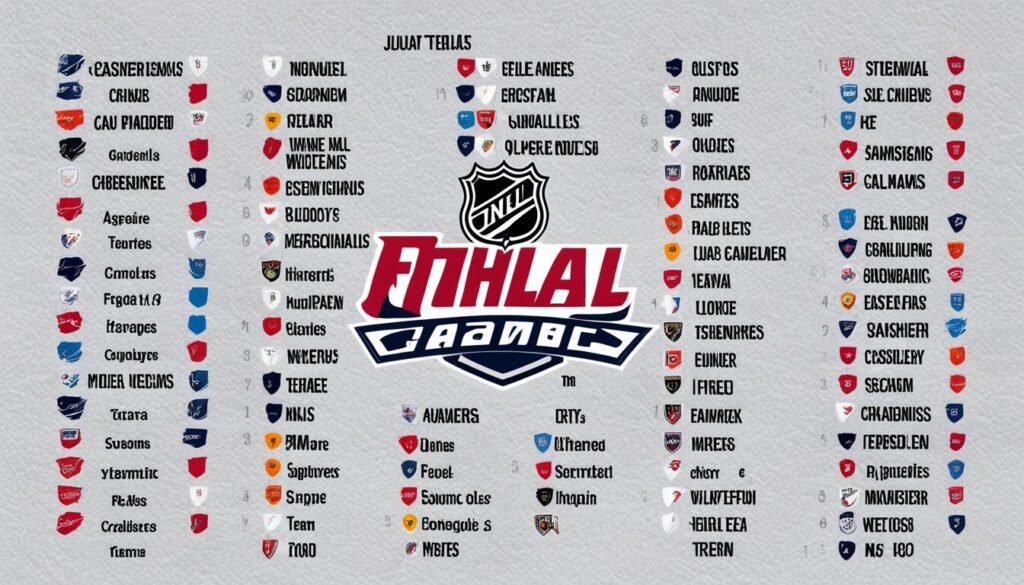As a hockey fan, understanding the NHL point system is crucial for keeping track of team standings and playoff qualification. The point system determines how teams earn points based on wins, losses, and overtime results. Let me break it down for you.
Key Takeaways:
- The NHL point system is used to determine team standings and playoff qualification in the National Hockey League.
- Teams earn two points for a win, regardless of regulation or overtime, and one point for an overtime loss.
- Regulation plus overtime wins (ROW) is used as a tiebreaker between teams with equal points in the standings.
- The top point-earning teams in each division and the top wild card teams qualify for the playoffs.
- The point system creates parity and keeps more teams in contention for the postseason.
How the NHL Point System Works
The NHL point system is a fundamental aspect of the league, determining a team’s rank in the standings and ultimately their qualification for the playoffs. Let’s take a closer look at how this scoring system operates.
In the NHL, teams earn points based on their performance in regular season games. A regulation win, where a team emerges victorious in the regular 60-minute play, grants them two points. On the other hand, a regulation loss results in zero points. In the event of a game going into overtime, the winning team is awarded two points, while the losing team receives one point.
This point allocation system ensures that winning teams are adequately rewarded, while still acknowledging the efforts of teams who manage to secure at least a point in overtime. It incentivizes teams to strive for success in regulation time or overtime in order to maximize their point accumulation.
Accumulating Season Points
Throughout the regular season, teams accumulate these points to establish their position in the standings. The teams with the highest point totals secure prime playoff spots, making it critical for every team to aim for a strong performance in every game.
Having a high number of season points not only signifies a team’s success, but it also determines their path to the playoffs. The top point-earning teams in each division, as well as the top wild card teams, advance to the postseason, creating an intense competition to secure these coveted positions.
To gain a better understanding of how the NHL point system affects team standings and playoff qualification, let’s take a look at a simplified example in the table below:
| Team | Wins | Losses | Overtime/Shootout Losses | Total Points |
|---|---|---|---|---|
| Tampa Bay Lightning | 48 | 18 | 4 | 100 |
| Toronto Maple Leafs | 44 | 22 | 4 | 92 |
| Boston Bruins | 41 | 24 | 5 | 87 |
In the example above, the Tampa Bay Lightning have accumulated 100 points by winning 48 games, losing 18, and losing 4 in overtime. This secure the team’s position at the top of the standings due to their exceptional point total.
On the other hand, the Toronto Maple Leafs and Boston Bruins, though still successful, have accumulated fewer points. The Maple Leafs have 92 points, while the Bruins have 87. These point differentials decide the rankings and ultimately impact playoff qualification.
Understanding the intricacies of the NHL point system allows fans to comprehend how their favorite team is performing and follow their progress throughout the season. This scoring structure creates thrilling competition and keeps fans engaged as they witness their team’s quest for victory.
Reading the NHL Standings
Understanding the NHL standings is essential for hockey fans to keep track of their favorite teams’ performance and playoff qualification. The standings provide a wealth of information about team performance, and various symbols and acronyms represent different aspects of the game.
Key Standings Metrics
When looking at the NHL standings, you’ll come across several important metrics:
- GP (Games Played): This indicates the number of games a team has played throughout the season.
- W (Wins): The total number of games a team has won.
- L (Losses): The total number of games a team has lost.
- OT (Overtime or Shootout Losses): The number of times a team has lost in overtime or a shootout.
- PTS (Points): A team earns two points for a win, one point for an overtime loss, and zero points for a regulation loss.
- ROW (Regulation Plus Overtime Wins): This tiebreaker metric counts the number of wins a team has achieved in regulation or overtime.
- GF (Goals For): The total number of goals a team has scored.
- GA (Goals Against): The total number of goals a team has conceded.
- DIFF (Goal Differential): The difference between goals scored and goals conceded.
Additional Standings Information
The standings also provide significant additional details:
- Home and away records: Teams’ performance in home games (recorded as “Home”) and away games (recorded as “Away”)
- Last 10 games: A team’s performance in the last 10 games, showcasing recent form and momentum
By analyzing these standings metrics, fans can gain insights into a team’s overall performance and their chances of making the playoffs. It helps fans understand how their favorite team compares to other teams in the league and their progress towards postseason qualification.


Divisional and Wild Card Playoff Qualification
The NHL playoffs consist of teams that earn enough points during the regular season to qualify for divisional or wild card spots. The top three point-earning teams in each division automatically qualify for the playoffs, while the remaining two spots in each conference are awarded to the top wild card teams. This format creates competition within divisions and conferences, as teams strive to secure a playoff spot. The point system determines which teams have the highest chance of postseason success.
To understand how teams qualify for the NHL playoffs, it’s essential to comprehend the divisional and wild card system. The top three teams from each division, based on points earned, secure guaranteed spots in the playoffs. These division winners are rewarded for their exceptional regular-season performance, gaining a favorable position in the postseason. Their consistent point accumulation throughout the season showcases their competitiveness and places them in contention for the Stanley Cup.
However, the competition doesn’t end there. The remaining two playoff spots in each conference are awarded to the top wild card teams. These teams may come from any of the divisions within the conference but must earn enough points to secure their playoff berths. The wild card spots provide an opportunity for teams that may not have won their division but have still demonstrated their ability to compete at a high level.
The NHL point system plays a crucial role in determining which teams qualify for divisional and wild card playoff spots. Each win and loss, whether in regulation or overtime, contributes to a team’s point total. The teams with the highest point totals in each division and the top wild card teams earn their way into the playoffs. The point system creates a fair and competitive environment, rewarding consistent performance and ensuring that teams have a chance to compete for the ultimate prize in professional hockey.


By understanding the divisional and wild card playoff qualification process, fans can gauge their favorite team’s chances of making it to the postseason. They can track the standings, cheer on their team’s performance, and analyze the point system’s impact on their team’s standing in the league. The excitement of the playoff race intensifies as the regular season progresses, with teams battling for coveted playoff spots and the opportunity to compete for the Stanley Cup.
Tiebreakers and the Importance of ROW
In the NHL standings, points determine a team’s position. However, in the event of a tie in points between two or more teams, tiebreakers come into play to determine playoff qualification. Let’s explore the various tiebreakers and understand the significance of Regulation plus Overtime Wins (ROW).
Tiebreakers in NHL Standings
When teams have the same number of points, tiebreakers are implemented to determine their rankings. The tiebreakers are applied in a specific order:
- Regulation Wins (RW): This is the first tiebreaker. It refers to the total number of wins achieved within the designated regulation time (excluding overtime and shootouts).
- Total Wins (W): If teams have an equal number of regulation wins, the tiebreaker shifts to the total number of wins, including those obtained in overtime or shootouts.
- Regulation plus Overtime Wins (ROW): If the tie remains unresolved after the first two tiebreakers, ROW becomes the deciding factor. ROW takes into account wins achieved in regulation and overtime, excluding shootout victories.
The significance of ROW cannot be overstated when it comes to playoff qualification. Teams that excel in regulation or overtime have an advantage over teams relying heavily on shootout wins. ROW provides a fair assessment of a team’s overall performance and emphasizes the importance of earning points within the designated playing time.
Importance of ROW in Determining Playoff Positioning
ROW has a direct impact on a team’s placement in the standings. It can be the determining factor between making the postseason or missing out. Let’s consider the following hypothetical scenario:
| Team | Points | ROW |
|---|---|---|
| New York Rangers | 96 | 40 |
| Philadelphia Flyers | 96 | 36 |
| New Jersey Devils | 96 | 35 |
In this example, three teams have the same number of points. However, the New York Rangers have the highest ROW, giving them an advantage over the Philadelphia Flyers and New Jersey Devils. As a result, the Rangers secure a higher playoff position, demonstrating the significance of ROW in determining postseason qualification and positioning.
Understanding tiebreakers and the importance of ROW ensures a comprehensive understanding of the NHL point system. It allows fans to analyze playoff possibilities and appreciate the strategic importance of winning in regulation and overtime.
Conclusion
The NHL point system is a crucial component of the league, determining team standings and playoff qualification. It incentivizes teams to pursue victories in regulation or overtime, as they earn the maximum two points for these wins. Additionally, the regulation plus overtime wins (ROW) tiebreaker puts an emphasis on winning games without the need for a shootout, adding strategic importance to each match.
The NHL standings provide fans with a comprehensive view of where their favorite teams stand in the race for playoff qualification. By understanding the point system and reading the standings, fans can track their team’s progress throughout the season and gauge their chances of postseason success.
Whether you’re an avid hockey fan or new to the sport, comprehending the NHL point system and navigating the standings guide will enhance your enjoyment of the game. So grab your favorite team’s jersey and get ready to cheer them on as they battle their way to the playoffs!

